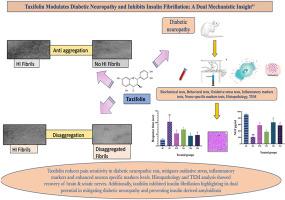“Taxifolin调节糖尿病神经病变和抑制胰岛素颤动:双重机制的见解”。
IF 8.2
2区 生物学
Q1 BIOCHEMISTRY & MOLECULAR BIOLOGY
引用次数: 0
摘要
糖尿病性神经病变(DN)是一种影响周围神经的病理疾病,是由神经纤维脱髓鞘受损引起的。利用药用植物中植物化学物质的已知治疗潜力,特别是在神经退行性疾病中,本研究旨在评估紫杉醇蛋白作为抗淀粉样蛋白生成剂在人类胰岛素淀粉样蛋白形成中的作用,以及它在减轻雄性Wistar大鼠糖尿病周围神经病变(DPN)中的功效。使用各种生物物理技术,包括光散射试验、硫黄酮T试验、远紫外圆二色光谱和透射电子显微镜,全面证明了taxifolin的抗纤颤作用,即使是在非常低的浓度下,也能对人胰岛素纤维性颤动起作用。此外,taxifolin被证明以浓度依赖的方式破坏预先形成的人胰岛素原纤维。在体内成分中,与链脲佐菌素-糖尿病对照组相比,taxifolin治疗的大鼠在与神经病变相关的行为参数(如痛感过敏和异常性疼痛)方面表现出显著差异。认识到氧化应激参与神经元细胞损伤,taxifolin被发现减少活性氧(ROS)的产生并抑制促炎细胞因子,特别是肿瘤坏死因子-α (TNF-α)和神经生长因子(NGF)。此外,通过组织病理学和透射电镜(TEM)分析,在大鼠大脑和坐骨神经中观察到结构改变,强调了taxifolin的多方面神经保护作用。本文章由计算机程序翻译,如有差异,请以英文原文为准。

"Taxifolin modulates diabetic neuropathy and inhibits insulin fibrillation: A dual mechanistic insight"
Diabetic neuropathy (DN), a pathological condition impacting peripheral nerves, is caused by the demyelination of nerve fibers due to damage to the protective myelin sheath. Leveraging the known therapeutic potential of phytochemicals from medicinal plants, particularly in neurodegenerative disorders, this research aimed to evaluate taxifolin's role as an anti-amyloidogenic agent on human insulin amyloid formation and its efficacy in alleviating diabetic peripheral neuropathy (DPN) in male Wistar rats. The anti-fibrillatory effect of taxifolin, even at very low concentrations, on human insulin fibrillation was comprehensively demonstrated using various biophysical techniques, including light scattering assay, Thioflavin T assay, far-UV Circular Dichroism spectroscopy, and Transmission Electron Microscopy. Additionally, taxifolin was shown to destabilize preformed human insulin fibrils in a concentration-dependent manner. In the in-vivo component, taxifolin-treated rats exhibited a significant divergence in behavioral parameters associated with neuropathy, such as hyperalgesia and allodynia, when compared to streptozotocin-diabetic controls. Recognizing the involvement of oxidative stress in neuronal cell damage, taxifolin was found to reduce the generation of reactive oxygen species (ROS) and suppress pro-inflammatory cytokines, specifically tumor necrosis factor-alpha (TNF-α) and nerve growth factor (NGF). Furthermore, structural alterations were observed in rat brains and sciatic nerves through histopathological and transmission electron microscopic (TEM) analyses, underscoring taxifolin's multifaceted neuroprotective effects.
求助全文
通过发布文献求助,成功后即可免费获取论文全文。
去求助
来源期刊

Free Radical Biology and Medicine
医学-内分泌学与代谢
CiteScore
14.00
自引率
4.10%
发文量
850
审稿时长
22 days
期刊介绍:
Free Radical Biology and Medicine is a leading journal in the field of redox biology, which is the study of the role of reactive oxygen species (ROS) and other oxidizing agents in biological systems. The journal serves as a premier forum for publishing innovative and groundbreaking research that explores the redox biology of health and disease, covering a wide range of topics and disciplines. Free Radical Biology and Medicine also commissions Special Issues that highlight recent advances in both basic and clinical research, with a particular emphasis on the mechanisms underlying altered metabolism and redox signaling. These Special Issues aim to provide a focused platform for the latest research in the field, fostering collaboration and knowledge exchange among researchers and clinicians.
 求助内容:
求助内容: 应助结果提醒方式:
应助结果提醒方式:


